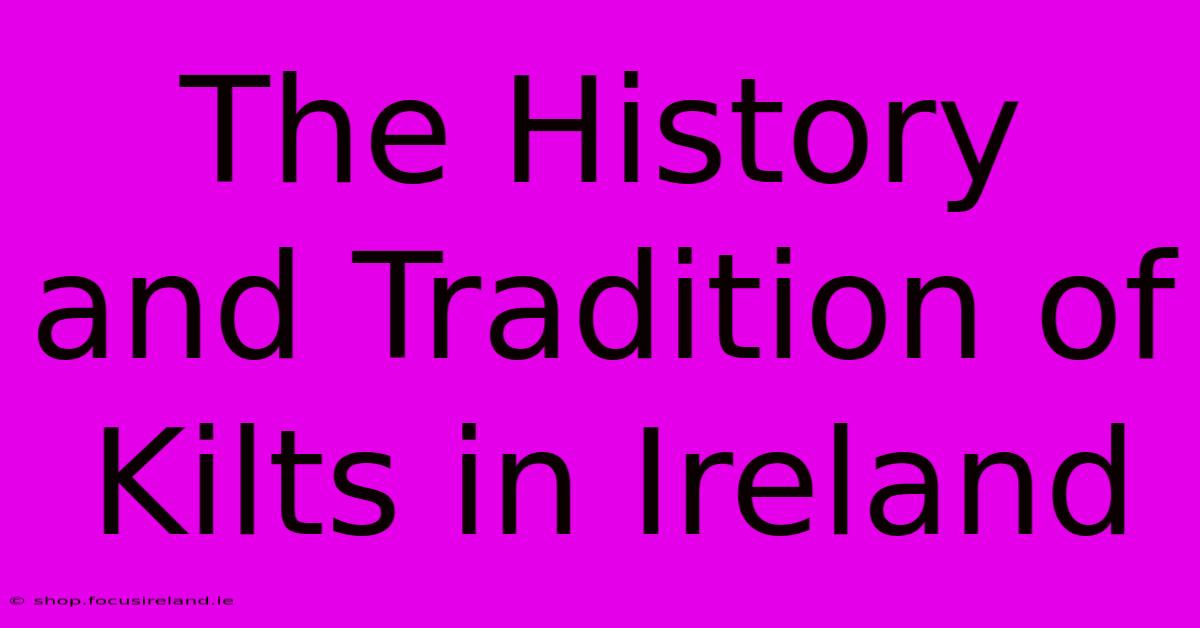The History And Tradition Of Kilts In Ireland

Table of Contents
The History and Tradition of Kilts in Ireland: More Than Just a Skirt
The kilt, a garment often associated with Scotland, holds a surprising and often misunderstood connection to Ireland. While not as prominently featured in Irish cultural iconography as in Scotland, the kilt's history and potential presence in Ireland warrant exploration. This article delves into the fascinating story of the kilt and its possible ties to the Emerald Isle.
Debunking the Myth: Kilts and Irish History
The image of a kilted Irishman is rarely seen, and for good reason: the kilt, in its modern form, isn't traditionally Irish attire. The kilts we associate with Scotland's Highland clans developed primarily in the 18th century. While earlier forms of draped clothing existed in both Scotland and Ireland, they differed significantly from the modern kilt. Irish clothing traditions featured a range of tunics, trousers, and cloaks, often made from wool and linen, reflecting the country's unique climate and history.
Early Irish Garments: A Different Story
Pre-18th-century Irish clothing often consisted of a léine (a linen tunic), brae (a type of cloak or mantle), and triubhas (trousers). These garments provided practical warmth and protection and varied in style based on social class and region. The notion of a single, defining garment similar to the modern kilt is simply not applicable to historical Irish clothing. Attempts to connect specific types of early Irish clothing to the modern kilt are largely speculative and lack substantial historical evidence.
The Influence of Scottish Culture
The strong historical ties and cultural exchange between Ireland and Scotland undeniably influenced clothing styles on both sides of the Irish Sea. However, it's crucial to avoid conflating these influences with a direct lineage of the kilt in Irish tradition. The prevalence of kilts in popular representations of Irish culture is often a result of broader misconceptions and the romanticized image of Celtic identity.
Modern Interpretations and Revivals
In recent times, some individuals and groups in Ireland have adopted kilts as a form of expressing Celtic heritage. This adoption, however, represents a modern interpretation rather than a revival of a pre-existing tradition. This appropriation reflects a broader trend of reclaiming and reinterpreting Celtic identity, but it’s important to understand this as a distinct phenomenon from the historical wearing of kilts in Ireland.
Separating Fact from Fiction: Avoiding Cultural Appropriation
It's crucial to maintain historical accuracy and avoid misrepresenting Irish clothing traditions. While celebrating shared Celtic heritage is important, this should be done responsibly and respectfully. Attributing kilts to Irish culture without acknowledging their primarily Scottish origins risks misrepresenting history and potentially appropriating a significant aspect of another nation's cultural identity.
Conclusion: Understanding the Nuances
The relationship between Ireland and the kilt is complex. While shared Celtic ancestry undoubtedly influenced clothing styles in both countries, the kilt as we know it today is not a traditional element of Irish attire. Acknowledging this distinction allows for a more accurate understanding of Irish cultural history and prevents the perpetuation of historical inaccuracies. Celebrating the rich and diverse heritage of Ireland means understanding its distinct clothing traditions, separating fact from fiction, and appreciating the unique cultural expressions of both Ireland and Scotland.

Thank you for visiting our website wich cover about The History And Tradition Of Kilts In Ireland. We hope the information provided has been useful to you. Feel free to contact us if you have any questions or need further assistance. See you next time and dont miss to bookmark.
Featured Posts
-
Scotland And Ireland Rejuvenate Your Soul
Apr 03, 2025
-
Pack Smart For Ireland In May Temperature Insights
Apr 03, 2025
-
Launch Your Career Irish Civil Service Opportunities
Apr 03, 2025
-
Unforgettable Memories Flights To Spain
Apr 03, 2025
-
Top Irish Cities A Comprehensive Overview
Apr 03, 2025
